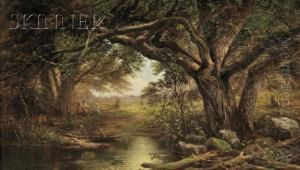Mary Josephine Walters Paintings
Mary Josephine Walters, often overlooked in the history of American art, was a 19th-century landscape painter born in 1837 in Brooklyn, New York. Not much is documented about her early life, but she is known to have been active in her artistic career predominantly during the latter part of the 19th century. Walters was part of the early wave of women artists in the United States who pursued art professionally, a challenging endeavor at a time when the art world was heavily dominated by men.
She studied under the tutelage of prominent Hudson River School painter Asher B. Durand, who was instrumental in her development as a landscape artist. Durand, known for his advocacy of painting directly from nature, likely influenced Walters' approach to her work. Her style was characterized by a delicate and detailed depiction of the natural world, displaying a strong affinity for the serene and pastoral landscapes that were a signature of the Hudson River School.
Despite the quality of her work, Walters did not gain significant recognition during her lifetime, a fate common among female artists of her era. Her paintings were, however, exhibited at various venues, including the prestigious National Academy of Design in New York, where she showed her work on several occasions. Her landscapes often featured serene bodies of water, lush greenery, and tranquil skies, capturing the transcendental beauty of the American wilderness.
After her death in 1883, Mary Josephine Walters' contributions to art were further overshadowed by her male contemporaries. It was only in later years that scholars and art historians began to re-evaluate her work and acknowledge her role in the development of American landscape painting. Today, her paintings can be found in private collections and occasionally on display in museums, representing the talents of women artists in an era when their artistic voices were seldom heard.
